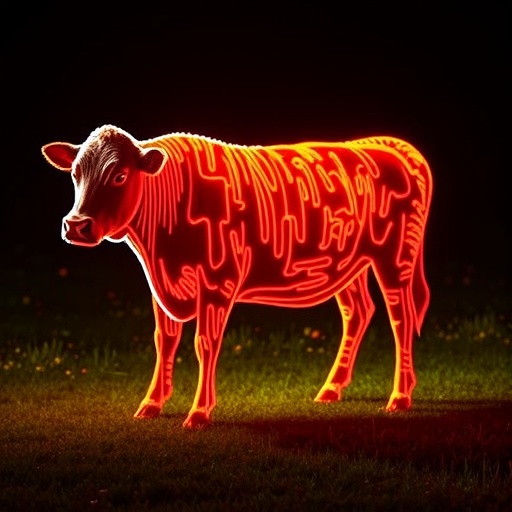In a groundbreaking study, researchers Liang, Li, and Zhang, along with their colleagues, have pioneered a novel analytical approach that fuses Weighted Gene Co-expression Network Analysis (WGCNA) with competing endogenous RNA (ceRNA) assessment. This innovative methodology has unveiled new insights into the complex biological processes governing bovine intramuscular fat deposition. The revelation not only amplifies our comprehension of bovine physiology but also holds significant implications for the livestock industry and meat production quality.
Bovine intramuscular fat, often referred to as marbling, is crucial for determining meat quality and consumer preference. The presence of intramuscular fat enhances flavor, tenderness, and overall palatability, making it a vital trait for beef production. Understanding the genetic and molecular underpinnings that influence fat deposition in cattle can lead to more effective breeding strategies and improved meat quality.
The integration of WGCNA and ceRNA analysis opens a new frontier in agricultural genomics. WGCNA is a system biology method used to describe the correlation patterns among genes across microarray samples. By employing this technique, the researchers identified modules of co-expressed genes associated with fat deposition traits in bovines. These gene modules serve as a blueprint for understanding the intricate interactions that occur at a molecular level during fat accumulation in muscle tissues.
Competing endogenous RNA (ceRNA) analysis further enriches the scope of this study. ceRNA molecules, which include long non-coding RNAs and circular RNAs, can interact with microRNAs to regulate gene expression. By decoding how these RNA entities compete for shared microRNA binding sites, the researchers were able to delineate a regulatory network that influences the expression of crucial genes involved in fat metabolism. This insight could lead to the identification of novel genetic targets for selective breeding.
The implications of the findings from this study extend beyond academic curiosity; they touch upon the practical realities of meat production worldwide. There is an increasing demand for high-quality beef that meets consumer preferences, and advances in genetic understanding hold the key to meeting this demand. By elucidating the regulatory networks affecting intramuscular fat deposition, scientists and breeders can work together to develop cattle that produce superior meat characteristics.
Additionally, the study’s methodologies and findings emphasize the importance of multi-faceted approaches in research. Instead of relying solely on traditional genetic analysis, the integration of network-based science with RNA biology provides a richer perspective on complex traits. Such an approach encourages researchers to think beyond single-gene analyses, advocating for a comprehensive view that encompasses the dynamic interactions of various biological molecules.
The researchers also explored how environmental factors, such as diet and management practices, could influence gene expression within the identified networks. By dissecting these interactions, they pave the way for developing optimized feeding regimens that can further enhance intramuscular fat deposition, leading to high-quality beef that aligns with industry standards. The results of this study thus hold relevance for both animal welfare and consumer expectations.
Moreover, the research provides a solid foundation for future studies aimed at unraveling the genetic complexities of other economically important livestock traits. The methodologies demonstrated in this study can be adapted to explore various phenotypes, thereby broadening the scope of agricultural genomics. As agriculture faces challenges posed by climate change and evolving consumer preferences, such innovative research is essential in guiding sustainable practices.
As the study continues to garner attention within the scientific community, the potential for collaborations and advancements increases. The demand for interdisciplinary research that combines genomics, nutrition, and animal science is more critical than ever. This study exemplifies how collaborative approaches can yield significant breakthroughs in our understanding of animal biology.
Furthermore, the publication of the research in a reputable journal not only offers validation to the authors but also amplifies the reach and impact of their findings. By sharing their insights with a broader audience, the researchers contribute to a growing body of knowledge that informs both academic peers and the agricultural industry. This intersection of expertise and application is vital for progressing towards enhanced livestock production systems.
In conclusion, the integration of WGCNA and ceRNA analysis presents an exciting leap in our understanding of bovine intramuscular fat deposition. By elucidating the complex gene regulatory networks involved, this research not only enriches the scientific discourse but also serves as a practical guide for future breeding and management strategies in livestock. The journey towards an era of precision agriculture is bolstered by such studies, as they empower scientists and practitioners alike to make informed decisions that benefit both animals and consumers.
Subject of Research: Insights into bovine intramuscular fat deposition through WGCNA and ceRNA analysis.
Article Title: The integration of WGCNA and ceRNA analysis provides insights into bovine intramuscular fat deposition.
Article References:
Liang, J., Li, C., Zhang, Y. et al. The integration of WGCNA and ceRNA analysis provides insights into bovine intramuscular fat deposition.
BMC Genomics 26, 865 (2025). https://doi.org/10.1186/s12864-025-12097-5
Image Credits: AI Generated
DOI:
Keywords: Bovine intramuscular fat, WGCNA, ceRNA, meat quality, livestock genetics, gene expression, dietary influence, agricultural genomics.




